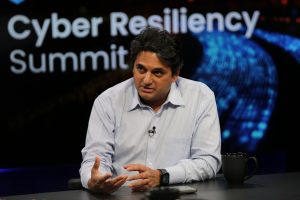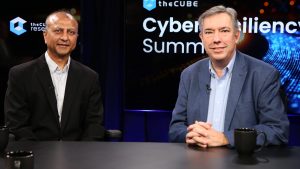 SECURITY
SECURITY
 SECURITY
SECURITY
 SECURITY
SECURITY
Cyber resilience is no longer just an IT concern. It’s become a strategic imperative for businesses facing an onslaught of artificial intelligence-driven threats and sophisticated ransomware attacks. Organizations are adopting proactive, integrated approaches that blend technology, people and processes to safeguard operations and ensure business continuity in the face of evolving threats.
This shift demands collaboration across business functions, rigorous testing and strategic planning, according to industry analyst Jon Oltsik, during theCUBE’s recent Cyber Resiliency Summit.

Industry analyst Jon Oltsik talks with theCUBE about the transformation of cybersecurity strategies to address evolving threats such as AI-driven attacks and ransomware.
“Cyber resilience demands that type of collaboration and cooperation,” he told theCUBE. “You can buy all the technology you want, but we see this in cybersecurity all the time. People buy these technologies, they configure them poorly, they’re not updating them [and] they’re not tuning them. You have to put the effort in, and that means you have to understand the technology, which means you have to [have] the right people with the right skills.”
Oltsik shared his perspective with theCUBE Research’s Christophe Bertrand at the Cyber Resiliency Summit, during an exclusive broadcast on theCUBE, SiliconANGLE Media’s livestreaming studio. The event explored how leading organizations are evolving their cybersecurity strategies to combat AI-driven threats and ransomware through proactive planning, strategic partnerships and cutting-edge technology. (* Disclosure below.)
Here are three key insights you may have missed from theCUBE’s coverage:
As cyber threats grow in complexity, organizations are increasingly turning to AI and automation to enhance cyber resilience. These technologies are reshaping traditional approaches, ensuring operational stability and supporting business continuity while improving threat detection and response efforts.
Cyber resilience has moved beyond basic disaster recovery to become a core component of business security strategies, powered by AI-driven automation and real-time analytics, according to Dave Vellante (pictured, right), co-founder and chief analyst at theCUBE Research. No longer just a contingency plan, resilience is a foundation for business operations, driving stability, protecting data and supporting long-term growth in an increasingly interconnected digital landscape.
“The rise of ransomware [has] caused completely new thinking,” he said, during the event. “Whereas cyber recovery and backup and data protection used to be sort of an afterthought, it became an adjacency to cybersecurity. Now it’s a fundamental component of business resiliency and cybersecurity strategies.”
Integrating large language models and AI has broadened resilience capabilities, enabling organizations to address vulnerabilities more comprehensively. This expansion underscores the importance of predictive planning and operational readiness to support business continuity, according to John Furrier, executive analyst at theCUBE Research.
“With LLMs and AI, that aperture with cybersecurity is increasing,” he explained. “It’s kind of horizontal. It’s expanded to other capabilities because resilience is a concept that’s well understood by CISOs across apps. There’s actually resilience involved in the automation center as agents come in.”

Broadcom’s Vijay Ramachandran talks with theCUBE about how cybersecurity is evolving through private cloud and AI initiatives.
This evolution is evident in the shift from traditional disaster recovery methods to intelligent, AI-driven security frameworks. Enterprises are using AI to analyze threat patterns, identify potential vulnerabilities and implement proactive security measures, according to Vijay Ramachandran, vice president of product management, core infrastructure, at Broadcom.
“The attacks have become a lot more sophisticated,” he told theCUBE. “There are attacks that happen in memory where there’s no files involved. Previously, the legacy file-based scanning also doesn’t take into account some of the behavioral aspects of the attack. We have to evolve our infrastructure, our protection, to ensure that we not only look at the legacy way of protecting against attacks, but also [are] keeping up to date with the new ways of protecting against attacks.”
Private cloud solutions, such as VMware Cloud Foundation, give enterprises greater control over their infrastructure and data. This control allows for more tailored security measures, according to Ramachandran.
“Enterprises have full control with the private cloud, full control over their infrastructure, the resources,” he said. “They have control over the data, which is where most of the attacks aim for. We strongly believe that a private cloud done the right way can be the most secure infrastructure compared to a public cloud infrastructure.”
Here’s theCUBE’s complete video interview with Vijay Ramachandran:
As cyber threats grow in complexity, organizations are realizing that achieving effective resilience requires more than technology alone. Strategic partnerships and collaboration are essential to leveraging expertise and resources to fortify cyber defenses.
Dell Technologies Inc. has embraced this approach by expanding its managed detection and response services through a partnership with CrowdStrike Inc., according to Mihir Maniar, vice president of product and services at Dell. The company uses Next-Gen SIEM technology to integrate telemetry, which is proprietary telemetry from Dell’s backup portfolio.

Dell’s Mihir Maniar and Rob Emsley talks with theCUBE about Dell’s latest announcements and approach to data protection in a hybrid world.
“We integrate that inside the Next-Gen SIEM from CrowdStrike to collect all of the log information,” Maniar told theCUBE. “We built jointly with them 60 indicators of compromise that can be used to go and detect threats that could be occurring inside the backup portfolio.”
Beyond technology partnerships, a structured framework for data resilience is crucial to maintaining business continuity. Veeam Software Group GmbH outlines five critical pillars — backup, recovery, portability, security and artificial intelligence — that organizations must adopt to ensure comprehensive protection, according to Anand Eswaran (pictured, left), chief executive officer of Veeam.
“It obviously starts with backup and recovery; 96% of the time, the ransomware hackers [and] the bad actors start with trying to compromise the backups for a reason,” he told theCUBE, during the event. “Backup and recovery is critical; it’s the foundation.”
Managing unstructured data is also a key component of cyber resilience. Congruity360 InfoGov Inc. is addressing this challenge by leveraging data classification to provide organizations with actionable insights into their security posture, according to Mark Ward, chief operating officer at Congruity360.
“For example, are there files that exist in open shares with open read rights?” he told theCUBE. “Is there data in that environment that has [personally identifiable information] or sensitive or risk data? Is there data that hasn’t been accessed in over 10 years?”
Here’s theCUBE’s complete video interview with Mark Ward:
With the rise of sophisticated cyber threats, organizations are shifting their focus from prevention to rapid recovery, ensuring business operations can resume quickly after an attack. Prioritizing recovery-first strategies helps organizations protect their data and maintain business continuity, making it a cornerstone of modern cyber resilience efforts.
Index Engines Inc. advocates for a proactive recovery approach through Dell’s CyberSense solution, which helps businesses restore operations with clean, trusted data, according to Danielle Goode Coady, vice president of marketing at Index Engines.
“We need the backup, but we also need the recovery,” she told theCUBE. “When we can get customers to think about the recovery first, where they know that they’re going to recover from a clean backup, then the backup matters just as much.”

KnowBe4’s Perry Carpenter talks with theCUBE about KnowBe4’s human-centric cybersecurity strategies.
Organizations must adopt frameworks that support continuous compliance and contextual security to stay ahead of evolving threats. These strategies align cybersecurity initiatives with business goals, ensuring resilience beyond technical measures, according to Merritt Baer, chief information security officer at Recolabs Inc.
“What [organizations] care about are outcomes, [the] amount of downtime that you’ve been able to get rid of or bringing down the risk of a data breach or an intrusion,” she told theCUBE, during the event. “There are ways in which I think security runs into that problem that’s like the tree falling in the forest. A good day is one where no one actually knows that you have been working, where everything goes according to the business plan.”
Building a culture of cybersecurity awareness and adaptive learning remains crucial to cyber resilience, according to Perry Carpenter, chief human risk management strategist at KnowBe4 Inc. These actions help organizations minimize risks and respond more effectively to incidents.
“To really make a difference with all the data breaches that we’re seeing, awareness is not and it has never been enough,” he told theCUBE. “Human risk management is all about understanding human nature at its core and building programs [that] … work with human nature rather than against it.”
Here’s theCUBE’s complete video interview with Merritt Baer:
To watch more of theCUBE’s coverage of the Cyber Resiliency Summit 2025 event, here’s our complete event video playlist:
(* Disclosure: TheCUBE is a paid media partner. Sponsors do not have editorial control over content on theCUBE or SiliconANGLE.)
Support our mission to keep content open and free by engaging with theCUBE community. Join theCUBE’s Alumni Trust Network, where technology leaders connect, share intelligence and create opportunities.
Founded by tech visionaries John Furrier and Dave Vellante, SiliconANGLE Media has built a dynamic ecosystem of industry-leading digital media brands that reach 15+ million elite tech professionals. Our new proprietary theCUBE AI Video Cloud is breaking ground in audience interaction, leveraging theCUBEai.com neural network to help technology companies make data-driven decisions and stay at the forefront of industry conversations.